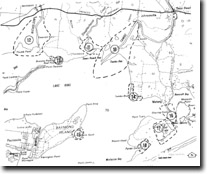GL11 (8422) Slaughterhouse Creek
|
This information has been developed from the publications:
|
| Location: | 690106 (8422). 1 kilometre west of Tambo River delta. | |
Abstract: | Swamp filled valley enclosed by spits. | |
Access: | Boat access from Lake King shoreline. | |
Ownership: | Private land. | |
Geology/Geomorphology: | Slaughterhouse Creek and its tributary Butcher Creek are small streams that have incised deep valleys into the coastal terrace north of Lake King. The system is typical of many streams that enter the Gippsland Lakes in that the valleys have been deepened by river incision during glacial phases of low sea level and then submerged by the Holocene marine transgression to form elongated branching inlets. | |
The mouth of Slaughterhouse Creek has been deflected and largely enclosed by several broad recurving sand and gravel spits surmounted by beach ridges. These spits have grown towards the north-west under the influence of wave action and longshore drift, generated by westerly winds. There is abundant material for spit growth from the sediment load delivered to Lake King by the Tambo and Mitchell rivers and from erosion of the low bluffs and cliffs around Swan Reach Bay. | ||
Significance: | The constricted entrance to the creek from Lake King has sheltered the inlet from erosive wave action and also reduced the inflow of brackish lake water. The inlet has thus maintained a growth of reed swamp although salt marsh vegetation is extending. Sedimentation has proceeded rapidly, and the inlet is now occupied by a broad alluvial and swampy flat. Low levee banks border Slaughterhouse Creek and drainage from these has produced long narrow back swamp lagoons against the valley side bluffs. | |
Management: | Regional. This is a clear example of the importance of a change in shoreline orientation producing spit growth as at the mouth of Slaughterhouse Creek. The alluviation in the valley demonstrates the origin of much of the wetlands adjacent to the Gippsland Lakes. | |
Removal of the spits or widening and deepening of the entrance to Lake King would result in increased tidal flow in the creek, possibly leading to erosion and other ecological changes in Slaughterhouse Creek. | ||



